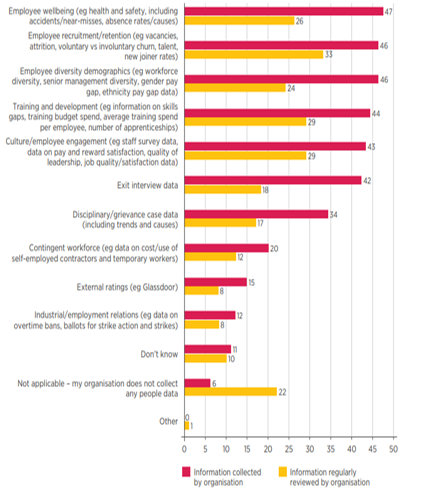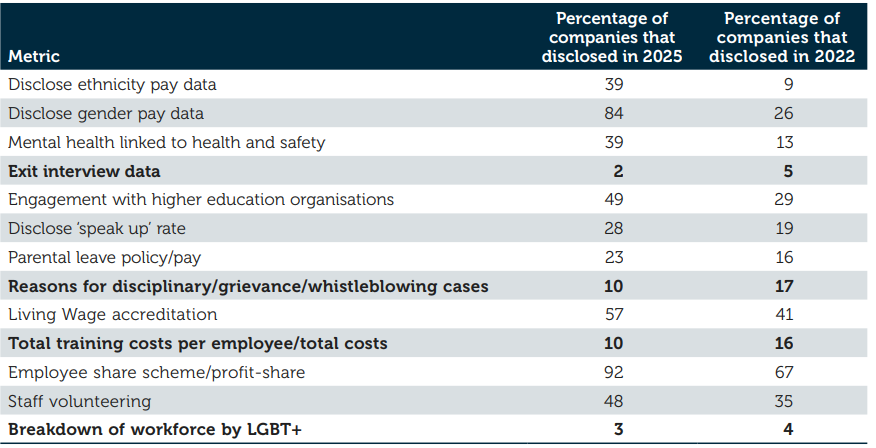“There is a clear imbalance between data and narrative in company reports, with excessive emphasis on narrative that is often anecdotal and less materially relevant at the expense of hard, comparable data”. A blog by HPC researcher Paddy Goffey exploring the challenges that prevent effective workforce reporting and how this can be improved in the future.
Corporate reporting has recently come under increasing fire from business voices who argue it amounts to an excessive ‘reporting burden’, draining time and resources while offering little practical benefit. While reporting can often include superfluous narrative that offers little insight into company practice, a recent CIPD and Railpen report supported by HPC titled the ‘Future of Workforce Reporting’ argues that workforce reporting must be re-framed as an essential tool in harnessing the full-potential of the workforce.
The below CIPD graph depicts how, even in the minority of cases where companies do collect relevant workforce data, this is often not reviewed or used as a basis for improving practice. Such a discrepancy is indicative of how businesses often treat workforce disclosures as a box-ticking, compliance exercise. Given that just 10% of UK workers feel engaged in their jobs, and the associated business, productivity and wider societal costs this has, this is clearly something that both government and business should be concerned about.

The types of people metrics, data collected and data reviewed (% of respondents)
The importance of strong data is illustrated by research showing that firms with strong workforce analytics experience 30% greater operational efficiency than peers in times of crisis, while other studies link it with greater customer satisfaction. This shouldn’t come as a surprise; it makes sense that in cases where firms have gathered high-quality, detailed workforce data, they are more likely to understand skill gaps in the business, what is affecting employee morale and, ultimately, how greater productivity can be achieved.
The report details the below principles as crucial to ensuring such high-quality disclosure:
- be linked to a company’s strategy and performance
- include an appropriate mix of data and narrative
- be balanced and self-critical
- focus on targets
- use consistent data-points over time
- include both directly employed and contingent workers
- be disaggregated (where appropriate)
- have received some kind of independent, external assurance
As well as a lack of data on the crucial metrics for understanding workforce treatment, such as on staff turnover, whistleblowing and employee engagement, the analysis also finds the reporting practices of FTSE100 firms rarely meet these general principles. Namely, just 14% disclosed the extent of contingency workers in their operations, 11% were self-critical of their own employment practices and 48% detailed future targets as part of their KPIs or principal risks. These figures illustrate that, if such principles aren’t met, workforce disclosures risk becoming superficial, generic and excessively partisan assessments of company performance, lacking genuine accountability for failure to improve workforce management practices.
 Key changes in workforce reporting practices 2022-25 (%)
Key changes in workforce reporting practices 2022-25 (%)
Thankfully, the report isn’t all doom and gloom; there are multiple examples throughout demonstrating where firms have made positive efforts to understand their workforce and improve their own practice on the back of this. Understandably, developing the infrastructure to collect and engage with this data takes time, and companies can’t be expected to achieve perfection in this area overnight. Crucially, however, firms must be open about the challenges they are facing with regard to workforce management, even when the information provided may raise questions for stakeholders. Investors frequently told us they value honesty about challenges and where practice is below accepted standards, as such openness fosters productive dialogue, strengthens stakeholder relations and develops gradual improvement.
The report offers a number of recommendations to help develop these, making suggestions to all stakeholders that play a role in shaping, interpreting and engaging with workforce data:
- Companies: All large firms should seek to ensure they report on the crucial people metrics that provide insight into company practice and are relevant across all sectors and business models. This should include workforce composition, wellbeing, reward and skills, referencing clear targets and progress updates on these. To help focus these efforts, all annual reports should include a dedicated workforce section.
- Regulators: The FRC should consider providing clearer guidance to improve the consistency and comparability of workforce reporting under the UK Corporate Governance Code. This would help ensure more meaningful data and narrative, making it easier for stakeholders to interpret disclosures and enhancing comparability between companies.
- Investors: Investors should encourage and reward transparency, even in those cases where disclosure raises concerns. This would help ensure firms are transparent about the challenges they are facing, a crucial first-step in developing a roadmap toward better practice and performance.
- Government: Government must recognize the role that accreditation and verification mechanisms can have in supporting good workforce management. The UK Government recently consulted on a sustainability-related disclosure and assurance framework, including how businesses are affected by and impact on the environment. The same principle should be extended to apply to the social dimensions of business practice.
These proposals would work in conjunction with each other, strengthening the chain of data-collection, dialogue, engagement and accountability that influences corporate management of the workforce. Only through this holistic approach can workforce disclosures succeed in helping to ensure that employees across the UK feel heard, respected and supported by their employers to succeed in their roles.